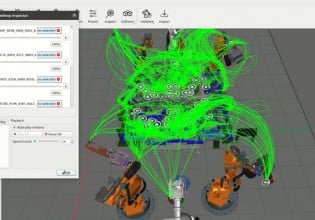How to Use Data to Drive Digital Transformation
As the tangible world can be costly and consumes natural resources, digital transformation is reducing cost and providing more options to consumers. How is data driving digital transformation, and what is to come next in a digital world?
This short series covers drivers in digital transformation. Below are links to previous articles in the series.
- Does 3D Printing Continue to Drive Digital Transformation?
- The Relationship Between Predictive Maintenance and Digital Transformation
- How to Use Data to Drive Digital Transformation (you are here)
Many companies are trying to scale digital tools, such as monitoring, remote access, machine learning, and more. This article will take a look at how these technologies are helping to drive the future of manufacturing.
Using the Right Data
Engineers are typically taught how statistics and math are used to make decisions. Engineers are also taught that it is important to use the right data and equations for accurate results.
Today, there are more ways to get data than ever before. Unfortunately, having too many options and too much data can leave companies inundated.
Connected devices need to do more than simply measure and send data. Technicians need to know what the data means and how to respond to it. Additionally, raw data does not directly help managers make better decisions to find smart strategies. For these benefits, more data is needed, and it would be required from multiple sources to get an idea of a bigger picture.
For a holistic approach that uses data to find patterns and turn data into information, or suggestions, original equipment manufacturers (OEMs) responded with software, advanced HMIs, and built dashboards. Starting a digital transformation plan requires knowledge on where data or feedback would provide the most value.
Connectivity and Connected Dashboards
Connecting everything often results in higher costs and inundation. But, as the company's transformation scales, not taking advantage of mass data collection might allow them to miss the full benefits of this technology.
This larger scale of connectivity has accelerated dashboards. Service providers were able to use dashboards to gather data from multiple companies for larger data sets to improve accuracy and charge only for the services needed. Features could be enabled or disabled remotely with the click of a mouse.

Figure 1. A graphic showing different forms of cloud services.
Today, connected dashboards and cloud services can offer complex features, such as machine learning, artificial intelligence, and big data in simple, affordable packages, which is helping to drive digital transformations.
Companies trying to scale should be aware that more data sent over outside networks might come with security concerns. Most devices and services will come with some type of security feature. But, a digital transformation strategy should consider limiting access by identifying what is necessary to connect and where that data needs to go.
A trend in manufacturing is to process raw data on edge devices or locally. If a device is processing data locally, it minimizes lag, increases security, and reduces the cost of sending mass data over the internet. While starting a digital transformation, connected devices are providing data on ROIs, which can help justify the cost of more innovations.
Using basic engineering principles to find root causes and understand where a connected device would provide the greatest value is a good start. However, when scaling, companies need to take time to set up a strategy that should be easy to change as more information becomes available.
Advanced Features Adding Value to Digital Transformation
Once there are larger data sets from multiple sources, companies should stay focused on security. Additionally, with more data, it will be important to look into how more advanced cloud computing and features might add value to the digital transformation.

Figure 2. A modular robot cell. Image used courtesy of KUKA
Connected devices have already started to show how manufacturing might look in the future. Mobile robots and robotic cells are easily becoming popular trends and drivers in the digital space. While worker cells and mobile robots can operate independently, connecting this technology to more data, larger networks, or cloud services can open the door to faster, effective, more autonomous capabilities.
Digital tools such as monitoring, remote access, simulations, and more will continue to drive digital transformations in manufacturing. To stay competitive, manufacturing has to be able to function faster and more cost-effectively while delivering more benefits.
Many experts believe the only way to accomplish these goals with a growing population, limited resources, and an increase in environmental responsibility is to expand digitally.
Is your company embracing new technology and digital transformation?






